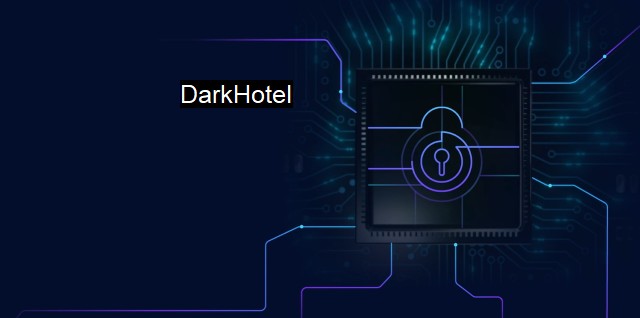What is DarkHotel?
DarkHotel: Inside A Highly Advanced Cyber Attack Targeting Business Travelers Through Hotel Wi-Fi Networks
DarkHotel is a cyber-espionage attack system that has debuted conspicuous activity detected back in 2007. It garnered its name because it specifically targets infected hotel Wi-Fi networks to compromise valuable information from senior executives and high-profile individuals primarily in the Asia-Pacific region. The basis of DarkHotel revolves around the sophisticated techniques implemented by cyber-criminals for illicit purposes.DarkHotel is an advanced persistent threat (APT) - a long-term targeted attack. This type of attack usually targets large organizations or governmental bodies for extended periods. Cybercriminals behind APKs sustain the attack until they know they have achieved desired levels of breach and infiltration. An interesting facet of DarkHotel’s modus operandi is how specific they are about their victims. They mainly prey upon select corporate executives traveling in APAC hotels, thus earning its distinctive pseudonym “DarkHotel.”
DarkHotel notably leverages hotel Wi-Fi networks as a starting point for its nefarious activities. The cybercriminals maintain a long-term position within these networks, targeting executives who opt to use the hotel's complimentary internet service during their stay. The attackers first administer a security prompt to the victim, warning about a supposed existing threat, then coercing the victims into installing a backdoor under the guise of a security update or software package.
After successfully convincing the user to execute the surreptitiously malicious update, the malware initiates a ‘spear-phishing’ method. Hackers meticulously design this digital trap by using emails rigged with malware, targeting particular high-profile individuals or corporations. Once the attacker secures an opening, they conduct various harmful activities such as digital surveillance, data theft, and establishing a firm grip for future attacks.
This extremely targeted attack style divides DarkHotel from other typical APT methods. Intruders pick and choose their victims based on suitability rather than context, assessing the notability market before storming in. It primarily devises traps and lures for industrial executives, politicians, and nationally acclaimed personalities.
In terms of antivirus and cybersecurity defenses, DarkHotel poses a particularly slippery challenge. Its unique framework results in a high risk for many given its selectivity and precision in targeting victims. Consequently, Internet security organizations need an effective strategy, implying an aggressive mix of real-time network monitoring, diligent structuring of digital protocols, collaborating with ISPs for comprehensive intelligence, and spreading awareness about phishing tactics.
Other beneficial practices entail system patch protocols to counter zero-day exploits, encouraging end-users to regularly update their software. Companies could also set guidelines for employees to prohibit unnecessary entry or installation of external software elements while connected to public networks.
Despite persistent efforts to nullify the activities of DarkHotel, it’s worrisome to witness the extensive organization and precision that describe their operations. A varied toolkit, nearly impenetrable network exploit maneuvers, and continued anonymity all point towards their adaptive nature, proving their resilience to basic security structures.
Conviontional countermeasures against this inveterate threat until effective anticipation methods develop comprise pragmatic end-user damasking protocols. Comprehensive awareness and behavioral regulation can mitigate the risks, if not completely prevent them. Detailing guidelines about the risks of spear-phishing tactics clouded as hotel Wi-Fi prompts and encouraging adherence to robust, updated software protocols.
As cybersecurity breaches progressively augment, Darkhotel exemplifies the evolving cyber threat landscape where generic defensive measures fall inadequate. Adapting to newer, undeciphered exploits mandates continuous learning and development in the cybersecurity spectrum. The phenomenon of DarkHotel confirms what many networks everywhere inherently fear: Once intruders settle in and have free reign, it's nearly impossible to eradicate them completely.

DarkHotel FAQs
What is Darkhotel and how does it work?
Darkhotel is a sophisticated hacking group that targets high-level executives and government officials who stay at high-end hotels. They use a technique called "watering hole" attacks, where they compromise the internet connection in the hotel, and inject malware into the software update process of commonly used applications such as Adobe Flash Player or Google Toolbar.How can I protect myself from a Darkhotel attack?
To protect yourself from Darkhotel attacks, make sure to use a Virtual Private Network (VPN) to encrypt your internet connection and avoid using public Wi-Fi networks. Also, keep your antivirus software up-to-date and avoid downloading software updates from unknown sources.What are the consequences of a Darkhotel attack?
A successful Darkhotel attack can lead to stolen sensitive information such as login credentials, financial information, and personal data. This information can be used for identity theft, fraud, or espionage. It can also jeopardize a company's reputation and lead to financial losses.How can companies protect their employees from Darkhotel attacks?
Companies can protect their employees from Darkhotel attacks by providing cybersecurity training that includes best practices for safe internet usage and identifying phishing scams. They can also implement secure communication channels and VPNs for remote access to sensitive data. Additionally, companies can enforce strict security protocols for employees who travel and require them to use company-provided devices with updated antivirus software.Related Topics
Advanced Persistent Threats (APTs) Zero-day exploits Malware Phishing Social engineering attacks
| | A | | | B | | | C | | | D | | | E | | | F | | | G | | | H | | | I | | | J | | | K | | | L | | | M | |
| | N | | | O | | | P | | | Q | | | R | | | S | | | T | | | U | | | V | | | W | | | X | | | Y | | | Z | |
| | 1 | | | 2 | | | 3 | | | 4 | | | 7 | | | 8 | | |||||||